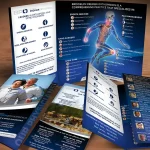In today’s digital age, having a well-designed corporate website is essential for any business looking to establish a strong online presence. A website serves as the virtual storefront for your company, and it is often the first point of contact for potential customers. A poorly designed website can leave a negative impression and drive visitors away, while a well-designed website can attract and engage users, ultimately leading to increased conversions and sales.
A well-designed corporate website not only enhances your online presence but also contributes to your company’s reputation. It showcases your professionalism, credibility, and attention to detail. A poorly designed website, on the other hand, can make your company appear untrustworthy or outdated. Therefore, investing in effective corporate website design is crucial for building a positive online reputation and attracting potential customers.
Key Takeaways
- Effective corporate website design is crucial for businesses to establish their online presence and attract potential customers.
- Maximizing online presence is important for businesses to reach a wider audience and increase brand awareness.
- Understanding the target audience is essential for creating a website that meets their needs and preferences.
- User-friendly website navigation is key to ensuring a positive user experience and keeping visitors engaged.
- Developing a consistent brand identity helps businesses establish a strong and recognizable online presence.
Importance of Maximizing Online Presence
Having a strong online presence is vital in today’s digital landscape. With the majority of consumers turning to the internet to research products and services before making a purchase, it is essential for businesses to be easily found online. A well-designed corporate website can help you reach a wider audience and increase brand awareness.
A website allows you to showcase your products or services 24/7, making it accessible to potential customers at any time. It also provides an opportunity to engage with your audience through interactive features such as blogs, forums, or live chat. By maximizing your online presence, you can establish yourself as an industry leader and build trust with your target audience.
Understanding Your Target Audience
Understanding your target audience is crucial for effective corporate website design. By knowing who your audience is and what they are looking for, you can tailor your website to meet their needs and expectations. Conducting audience research and creating user personas are effective ways to gain insights into your target audience.
Audience research involves gathering data on your target audience’s demographics, interests, behaviors, and preferences. This can be done through surveys, interviews, or analyzing website analytics. User personas, on the other hand, are fictional representations of your ideal customers. They help you understand your audience’s motivations, goals, and pain points, allowing you to create a website that resonates with them.
Creating a User-Friendly Website Navigation
Having a clear and intuitive website navigation is essential for providing a positive user experience. A well-designed navigation system allows users to easily find the information they are looking for and navigate through your website seamlessly. It reduces frustration and increases the likelihood of users staying on your site longer.
To create a user-friendly navigation system, it is important to keep it simple and organized. Use clear and concise labels for your navigation menu items and avoid overwhelming users with too many options. Consider implementing drop-down menus or mega menus for websites with a large amount of content. Additionally, make sure your navigation is consistent across all pages of your website to avoid confusion.
Developing a Consistent Brand Identity
Having a consistent brand identity across all online platforms, including your website, is crucial for building brand recognition and trust. Your website should reflect your company’s values, personality, and visual identity. Consistency in design elements such as colors, fonts, and imagery helps create a cohesive brand experience for your audience.
To create a consistent brand identity on your website, start by defining your brand’s visual elements such as logo, color palette, and typography. Use these elements consistently throughout your website to reinforce your brand identity. Additionally, ensure that the tone and voice of your website’s content align with your brand’s messaging and values.
Implementing Responsive Web Design
Responsive web design is an approach to web design that ensures your website looks and functions well on all devices and screen sizes. With the increasing use of smartphones and tablets, it is essential for businesses to have a mobile-friendly website. Responsive design allows your website to adapt to different screen sizes, providing a seamless user experience across devices.
Implementing responsive web design involves using flexible layouts, fluid images, and media queries to adjust the design and layout of your website based on the user’s device. This ensures that your website is easily accessible and readable on mobile devices, improving user engagement and reducing bounce rates.
Incorporating Search Engine Optimization (SEO)
Search Engine Optimization (SEO) is the practice of optimizing your website to improve its visibility in search engine results pages. A well-optimized website can attract organic traffic from search engines, increasing your chances of reaching potential customers.
To optimize your website for search engines, start by conducting keyword research to identify the keywords and phrases your target audience is using to search for products or services similar to yours. Incorporate these keywords naturally into your website’s content, meta tags, and URLs. Additionally, ensure that your website’s structure and navigation are search engine friendly, making it easy for search engines to crawl and index your site.
Enhancing Website Content and Visuals
High-quality website content and visuals are essential for engaging users and conveying your brand’s message effectively. Your website’s content should be informative, relevant, and easy to read. It should provide value to your audience and answer their questions or solve their problems.
When it comes to visuals, use high-resolution images that are visually appealing and relevant to your brand. Avoid using stock photos that look generic or unrelated to your business. Additionally, consider incorporating videos or interactive elements into your website to enhance user engagement.
Leveraging Social Media Integration
Social media integration can benefit your website in several ways. It allows users to easily share your content on social media platforms, increasing its reach and potential for virality. It also provides an opportunity to showcase your social media presence on your website, allowing users to connect with you on other platforms.
To integrate social media into your website, consider adding social sharing buttons to your blog posts or product pages. This allows users to share your content with their followers with just a click of a button. Additionally, consider embedding social media feeds or widgets on your website to display your latest posts or customer reviews.
Measuring and Analyzing Website Performance
Tracking website performance and analytics is crucial for understanding how your website is performing and identifying areas for improvement. By analyzing data such as website traffic, bounce rates, conversion rates, and user behavior, you can make data-driven decisions to optimize your website’s effectiveness.
To measure and analyze website performance, use tools such as Google Analytics or other web analytics platforms. Set up goals and conversion tracking to monitor specific actions or events on your website, such as form submissions or purchases. Regularly review your analytics data and make adjustments to your website based on the insights gained.
In conclusion, effective corporate website design is essential for establishing a strong online presence and building a positive reputation. By maximizing your online presence, understanding your target audience, creating a user-friendly navigation, developing a consistent brand identity, implementing responsive web design, incorporating SEO, enhancing website content and visuals, leveraging social media integration, and measuring and analyzing website performance, you can create a website that attracts and engages users, ultimately leading to increased conversions and sales. So don’t underestimate the power of effective corporate website design and start implementing these tips and strategies today.
If you’re looking to optimize your corporate website design, you may also be interested in learning about the importance of Google reviews for your business. In a related article, Bracha Designs explains why Google reviews are essential and provides tips on how to get more of them. Discover how positive reviews can enhance your online reputation and attract more customers by reading the article here.
FAQs
What is corporate website design?
Corporate website design refers to the process of creating and designing a website for a business or corporation. It involves creating a website that reflects the company’s brand, values, and goals.
Why is corporate website design important?
Corporate website design is important because it is often the first point of contact between a business and its potential customers. A well-designed website can help to establish credibility, build trust, and increase conversions.
What are the key elements of a corporate website design?
The key elements of a corporate website design include a clear and concise message, easy navigation, a responsive design, high-quality images and videos, and a strong call-to-action.
What are some best practices for corporate website design?
Some best practices for corporate website design include keeping the design simple and clean, using high-quality images and videos, optimizing the website for search engines, and making sure the website is mobile-friendly.
What are some common mistakes to avoid in corporate website design?
Some common mistakes to avoid in corporate website design include using too many colors or fonts, cluttering the website with too much information, using low-quality images or videos, and neglecting to optimize the website for search engines.
How can I ensure that my corporate website design is effective?
To ensure that your corporate website design is effective, you should conduct user testing, analyze website analytics, and continually make improvements based on feedback and data. It is also important to stay up-to-date with the latest design trends and technologies.















0 Comments